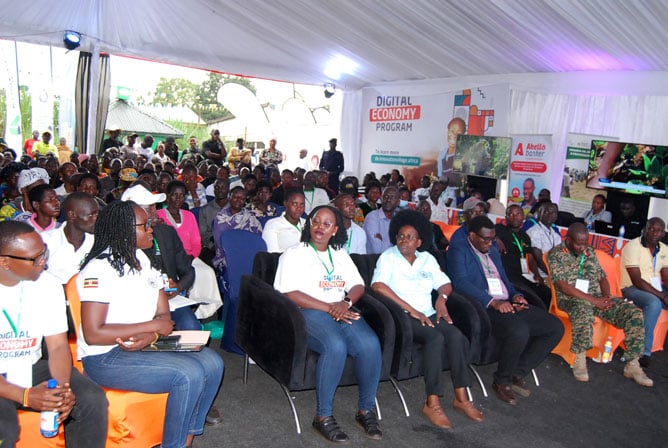Over 174000 farmers acquire digital skills

Some of the smallholder farmers, drawn from all over the country, at the ongoing 30th annual National Agricultural Show in Jinja City on August 2. PHOTO | PHILIP WAFULA
What you need to know:
- It is estimated that smallholder farmers make up approximately 89 per cent of Uganda’s farming population and produce up to 80 per cent of the nation’s total agricultural output.
The Innovation Village has made significant progress in digitalising last-mile communities in the agricultural sector through the Digital Economy Programme, a collaboration between the Mastercard Foundation and Mastercard Inc.
It is estimated that smallholder farmers make up approximately 89 per cent of Uganda’s farming population and produce up to 80 per cent of the nation’s total agricultural output.
However, such smallholder farmers, especially those in last-mile communities, often face significant challenges in accessing modern farming equipment, machinery, and digital resources to enhance their productivity.
This digital divide hampers their productivity and limits their ability to fully contribute to the country’s economic growth and improve their standard of living.
The Programme Manager, Mr Fredrick Mpaata, said the Digital Economy is about how we are using solutions, machines, technologies, new ideas to increase on our earnings and livelihoods in the communities where we stay.
Mr Mpaata says the programme started in 2022 with a few farmers who were largely inquiring how they can be part of the Digital Economy, after which they held stakeholder awareness sessions across the six sub-regions in the country with their partner, the Uganda National Farmers’ Federation (UNFFE).
Mr Mpaata told this publication on Thursday at the sidelines of the ongoing 30th annual National Agricultural Show in Jinja City, which ends on August 4 that about 174000 farmers are currently benefit from a range of their services.
This year’s edition is aimed at showcasing innovative solutions in the form of products or services that farmers can integrate into their farming practices to improve productivity and access to vital information, such as weather forecasts, market prices, and best farming practices.
Data from the Innovation Village suggests that between 2022 and 2024, the Digital Programme has impacted or had a total outreach of 174,491 smallholder farmers, up from 7,206.
Other beneficiaries are youth between the ages of 18 years and 35 years, whose outreach has grown from 7,206 to 95,712 during the same period, total youths with disabilities as of 2024 stands at 4,588, while total refugees increased from 3,622 in 2023 to 3,887 in 2024, among other statistics.
The Digital Economy Practice Lead at Innovation Village, Saul Weikama, says to-date, they have partnered with tech companies, including; Hamwe, MobiPay Agro-system Limited, and Service Corporate.
The Chief Executive Officer at aXiom Zorn, an AgTech data service provider, Ms Carol Kakooza, says farmers need to plug into digital technologies to grow their platform beyond their physical reach, and build a strong credit score database that they can leverage on their portfolio to access financial services, among others.
“Through our Digital Empowerment Platform, we bring together isolated production activities of smallholder farmers, businesses of agro dealers and SMEs to access low interest loans, provide certification for quality and safety control, and source suitable insurance policies for their produce to mitigate risk in losses,” she said.
Earlier, the Minister of Science, Technology, and Innovation (STI), Ms Monica Musenero said for the last two years, the STI Secretariat has been building a framework that creates pathways for the ‘new economy’.
“The framework entails making key sectors like agriculture, which were not traditionally part of the digital economy but significantly contribute to GDP, included in the new economy by leveraging STI,” she said.





